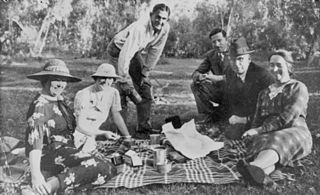
The Australia and New Zealand Banking Group Limited (ANZ) is an Australian multinational banking and financial services company headquartered in Melbourne, Victoria. It is Australia's second-largest bank by assets and fourth-largest bank by market capitalisation.

The Bank of New South Wales (BNSW), also known commonly as The Wales, was the first bank in Australia, being established in Sydney in 1817 and situated on Broadway. During the 19th century, the bank opened branches throughout Australia and New Zealand, expanding into Oceania in the 20th century. It merged with many other financial institutions, finally merging with the Commercial Bank of Australia in 1982 and being renamed to the Westpac Banking Corporation on 4 May that year under the Bank of New South Wales Act 1982.
The 1893 banking crisis in the Australian colonies involved the collapse of a considerable number of commercial banks and building societies, and a general economic depression. It occurred at the same time as the US Panic of 1893 (1893–1897).

The Bank of Australasia was an Australian bank in operation from 1835 to 1951.

The Colonial Bank of Australasia was a bank operating primarily in the Australian colony and then state of Victoria from 1856 to 1918.

The Sydney County Council (SCC) was formed in 1935 to produce electricity and operate the electricity network in a number of municipalities in metropolitan Sydney. Unlike other New South Wales county councils, which were voluntary associations of local councils to undertake local government activities permitted or required of them by the Local Governnment Act 1919, Sydney County Council was established under a separate piece of legislation by the state government to perform the electricity distribution and streetlighting operations of the local government areas concerned. On its establishment it assumed control of the Electricity Department of the Sydney City Council, which was already supplying electricity to other municipalities. In 1952, the SCC lost most its electricity generation functions to the Electricity Commission of New South Wales and retained only its distribution functions. The SCC was merged with other municipal county councils in 1990 to form Sydney Electricity.
The Federal Bank of Australia was established in Melbourne in 1881, and opened for business in April, 1882. Initially successful, the company expanded to New South Wales by absorbing the Sydney and Country Bank Limited in 1882. Banknotes were issued at branches in Melbourne, Sydney and Adelaide. The headquarters was in a modest building on the corner of Elizabeth and Collins Street in Melbourne.

Kuramia was a "K-class" ferry on Sydney Harbour. Commissioned in 1914, the timber-hulled steamer was built for Sydney Ferries Limited during the early twentieth boom in cross-harbour ferry travel. At 353 tons, she was the largest wooden ferry on Sydney Harbour.
MathewBuchan Jamieson, was a Scottish-born engineer in Australia, closely identified with the young town of Broken Hill, New South Wales.

Salome Jean White was the first female flying medical doctor in Australia and the world when she commenced work with the Australian Inland Mission in May 1937. She was known as the Guardian Angel of the Gulf.

The Borough of Victoria was a local government area in the Lower North Shore region of Sydney, New South Wales, Australia. First proclaimed as the Victoria Ward of the Borough of St Leonards in 1867, in 1871 a petition to secede was accepted and the Borough was proclaimed with an area of 0.7km2, making it the second-smallest council in Sydney after the Borough of Darlington. It included the modern suburbs of McMahons Point and parts of North Sydney and Lavender Bay. The borough lasted until 29 July 1890 when it merged with the neighbouring boroughs of St Leonards and East St Leonards to form the Borough of North Sydney.
Harold Crofton Sleigh was an Australian businessman, founder of H. C. Sleigh and Company, involved in shipping and petroleum distribution, best known for their "Golden Fleece" products and service stations.
Henry Anderson Howden was a Scottish-born Australian amateur golfer. He won the Victorian Golf Cup in 1896, 1897 and 1898 and the Australian Amateur in 1901.
Thomas Smith Bellair was an English actor who moved to Australia, where he had his own dramatic company before managing various hotels, finally settling in Wagga Wagga, where his family became prominent citizens.
The London Chartered Bank of Australia was an English-run Australian bank which operated from 1852 to 1921.
Henry Richard Harwood was an Australian actor and theatre manager.
Henry Osborne Jacobs was an English musician best known as an accompanist, arranger and conductor for Ada Reeve, then settled in Australia, where he had a substantial career.
The Howson family was a show-business dynasty founded in Australia, several of whose members went on to further success in America, London and Europe.
George Alfred Russell was an Australian businessman involved in several business ventures, finally acting as Australian manager for the North British Insurance Company.
Fanny Emily Mary Hooper, known as Minnie Hooper, was an Australian dance instructor and ballet mistress. She has been credited, with Jennie Brenan and Minnie Everett, with maintaining the high standard of Australian dance and ballet in the 1920s, between the reigns of Emilia Pasta and Anna Pavlova. She had a long series of contracts with J. C. Williamson's and conducted classes at her dance studio on Pitt Street, Sydney.










